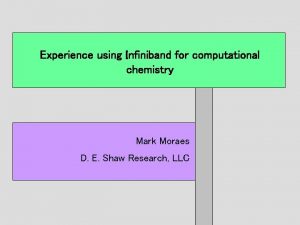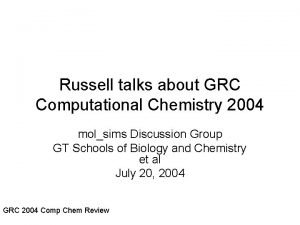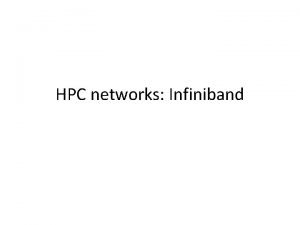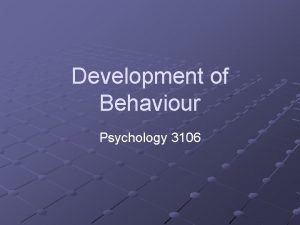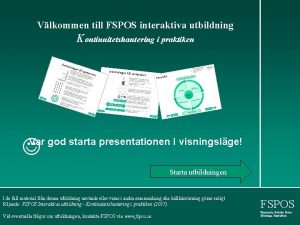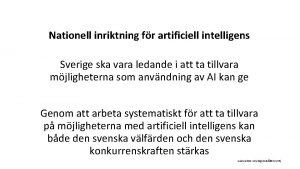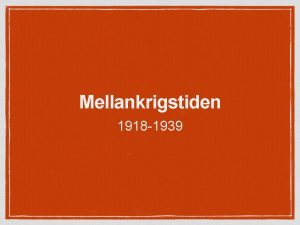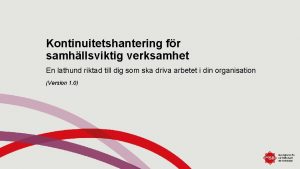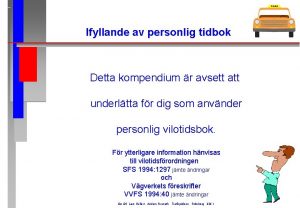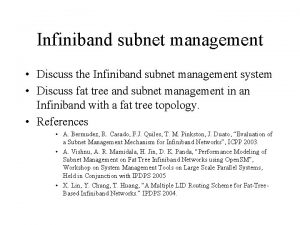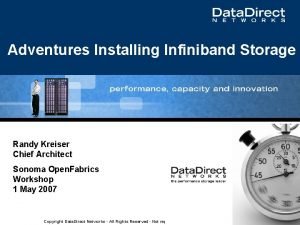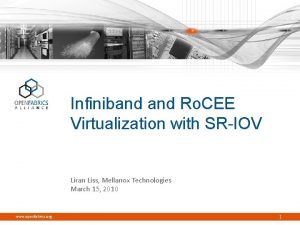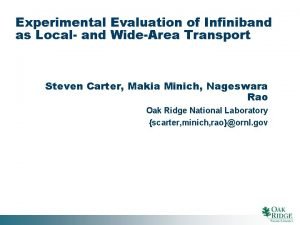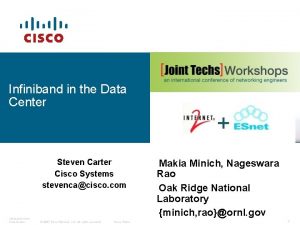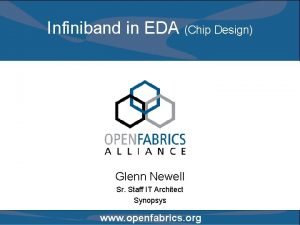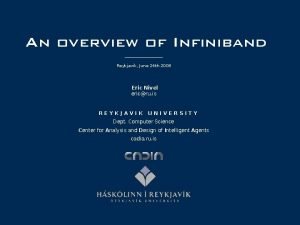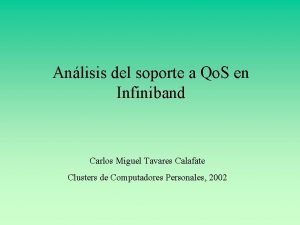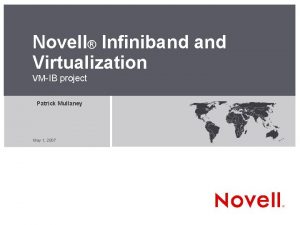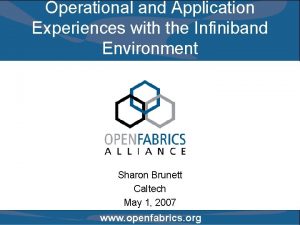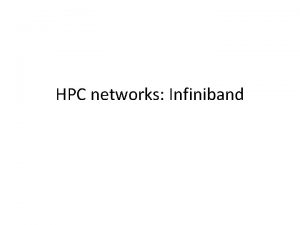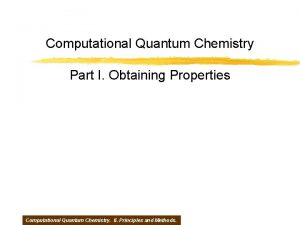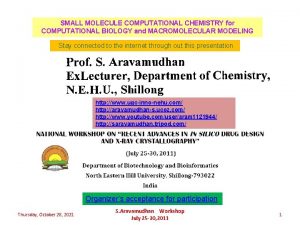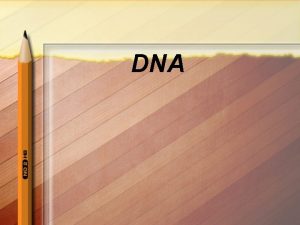Experience using Infiniband for computational chemistry Mark Moraes

Experience using Infiniband for computational chemistry Mark Moraes D. E. Shaw Research, LLC

Molecular Dynamics (MD) Simulation The goal of D. E. Shaw Research: Single, millisecond-scale MD simulations Why? That’s the time scale at which biologically interesting things start to happen

A major challenge in Molecular Biochemistry § Decoded the genome § Don’t know most protein structures § Don’t know what most proteins do – Which ones interact with which other ones – What is the “wiring diagram” of • Gene expression networks • Signal transduction networks • Metabolic networks § Don’t know how everything fits together into a working system

Molecular Dynamics Simulation Compute the trajectories of all atoms in a chemical system Iterate § 25, 000+ atoms § For 1 ms (10 -3 seconds) § Requires 1 fs (10 -15 seconds) timesteps 1012 timesteps Iterate with 108 operations per timestep => 1020 operations per simulation Years on the fastest current supercomputers & clusters

Our Strategy Parallel Architectures – Designing a specialized supercomputer (Anton, ISCA 2007, Shaw et al) – Enormously parallel architecture – Based on special-purpose ASICs – Dramatically faster for MD, but less flexible – Projected completion: 2008 Parallel Algorithms – Applicable to • Conventional clusters (Desmond, SC 2006, Bowers et al) • Our own machine – Scale to very large # of processing elements

Why RDMA? § Today: Low-latency, high-bandwidth interconnect for parallel simulation • Infiniband § Tomorrow: – High bandwidth interconnect for storage – Low-latency, high-bandwidth interconnect for parallel analysis • Infiniband • Ethernet

Basic MD simulation step Each process in parallel: § Compute forces (if own the midpoint of the pair) § Export forces § Sum forces for particles in homebox § Compute new positions for homebox particles § Import updated positions for particles in import region

Parallel MD simulation using RDMA Implemented with the Verbs interface. RDMA writes are used (faster than RDMA reads). § For iterative exchange patterns, two sets of send and receive buffers are enough to guarantee that send and receive buffers are always available § Send and receive buffers are fixed and registered beforehand § The sender knows all the receiver’s receive buffers and use them alternately

Refs: Kumar, Almasi, Huang et al. 2006; Fitch, Rayshubskiy, Eleftheriou et al. 2006

Apo. A 1 Production Parameters

Apo. A 1 Production Parameters



Management & Diagnostics: A view from the field § Design & Planning § Deployment § Daily Operations § Detection of Problems § Diagnosis of Problems

Design § HCAs, Cables and Switches: OK, that’s kinda like Ethernet. § Subnet Manager. Hmm, it’s not Ethernet. § IPo. IB: Ah, it’s IP. § SDP: Nope, not really IP. § SRP: Wait, that’s not FC. § i. SER: Oh, that’s going to talk i. SCSI. § u. DAPL: Uh-oh. . . § Awww, doesn’t connect to anything else I have! § But it’s got great bandwidth and latency. . . § I’ll need new kernels everywhere. § And I should *converge* my entire network with this? !

Design § Reality-based performance modeling. – The myth of N usec latency. – The myth of NNN Mi. B/sec bandwidth. § Inter-switch connections. § Reliability and availability. § A cost equation: – Capital – Install (cables and bringup) – Failures (app crashes, HCAs, cables, switch ports, subnet manager) – Changes and growth – What’s the lifetime?
![Deployment § De-coupling for install and upgrade: – Drivers [Understandable cost, grumble, mumble] – Deployment § De-coupling for install and upgrade: – Drivers [Understandable cost, grumble, mumble] –](http://slidetodoc.com/presentation_image/be8f8694a976280874cd1ef95457a700/image-17.jpg)
Deployment § De-coupling for install and upgrade: – Drivers [Understandable cost, grumble, mumble] – Kernel protocol modules [Ouch!] – User-level protocols [Ok] § How do I measure progress and quality of an installation? – Software – Cables – Switches

Gratuitous sidebar: Consider a world in which. . . § The only network that matters to Enterprise IT is TCP and UDP over IP. § Each new non-IP acronym causes a louder, albeit silent scream of pain from Enterprise IT. § Enterprise IT hates having anyone open a machine and add a card to it. § Enterprise IT really, absolutely, positively hates updating kernels. § Enterprise IT never wants to recompile any application (if they even have, or could find the source code)

Daily Operation § Silence is golden. . – If it’s working well. § Capacity utilization. – Collection of stats • SNMP • RRDtool, MRTG and friends (ganglia, drraw, cricket, . . . ) – Spot checks for errors. Is it really working well?

Detection of problems Reach out and touch someone. . . § SNMP Traps. § Email. § Syslog. A GUID is not a meaningful error message. Hostnames, card numbers, port numbers, please! Error counters: Non-zero BAD, Zero GOOD. Corollary: It must be impossible to have a network error where all error counters are zero.

Diagnosis of problems § What path caused the error? § Where are netstat, ping, ttcp/iperf and traceroute equivalents? § What should I replace? – Remember the sidebar – Software? HCA? Cable? Switch port? Switch card? § Will I get better (any? ) support if I’m running – the vendor stack(s)? – or the latest OFED?

A closing comment. Our research group uses our Infiniband cluster heavily. Continuously. For two years and counting. Our Infiniband interconnect has had fewer total failures than our expensive, enterprise-grade Gig. E switches.

Questions? moraes@deshaw. com

Leaf switches and core switches and cables, oh my! Core switch Leaf switch Core switch . . . 10 more Leaf switch . . . 86 more 12 servers
- Slides: 24
